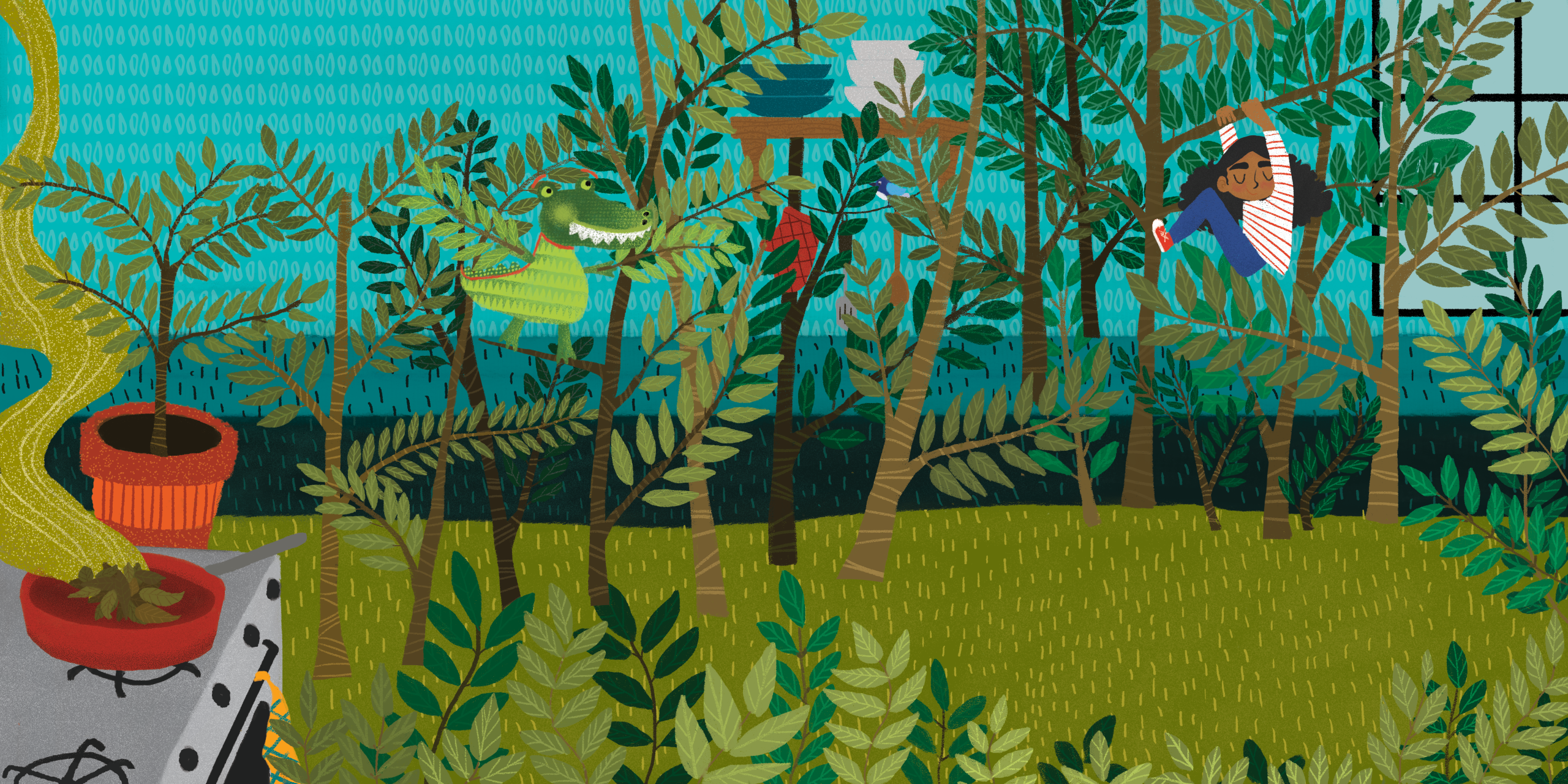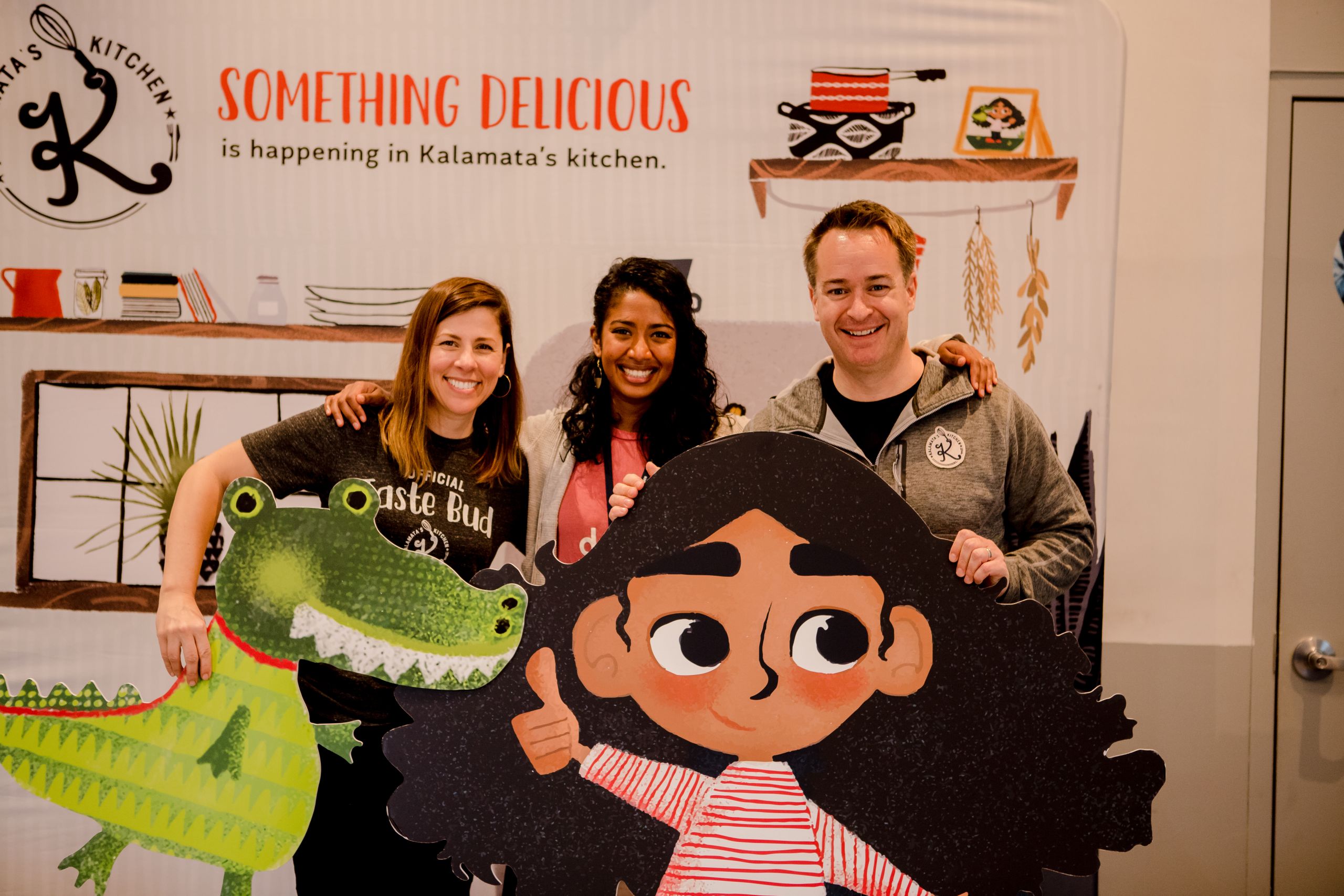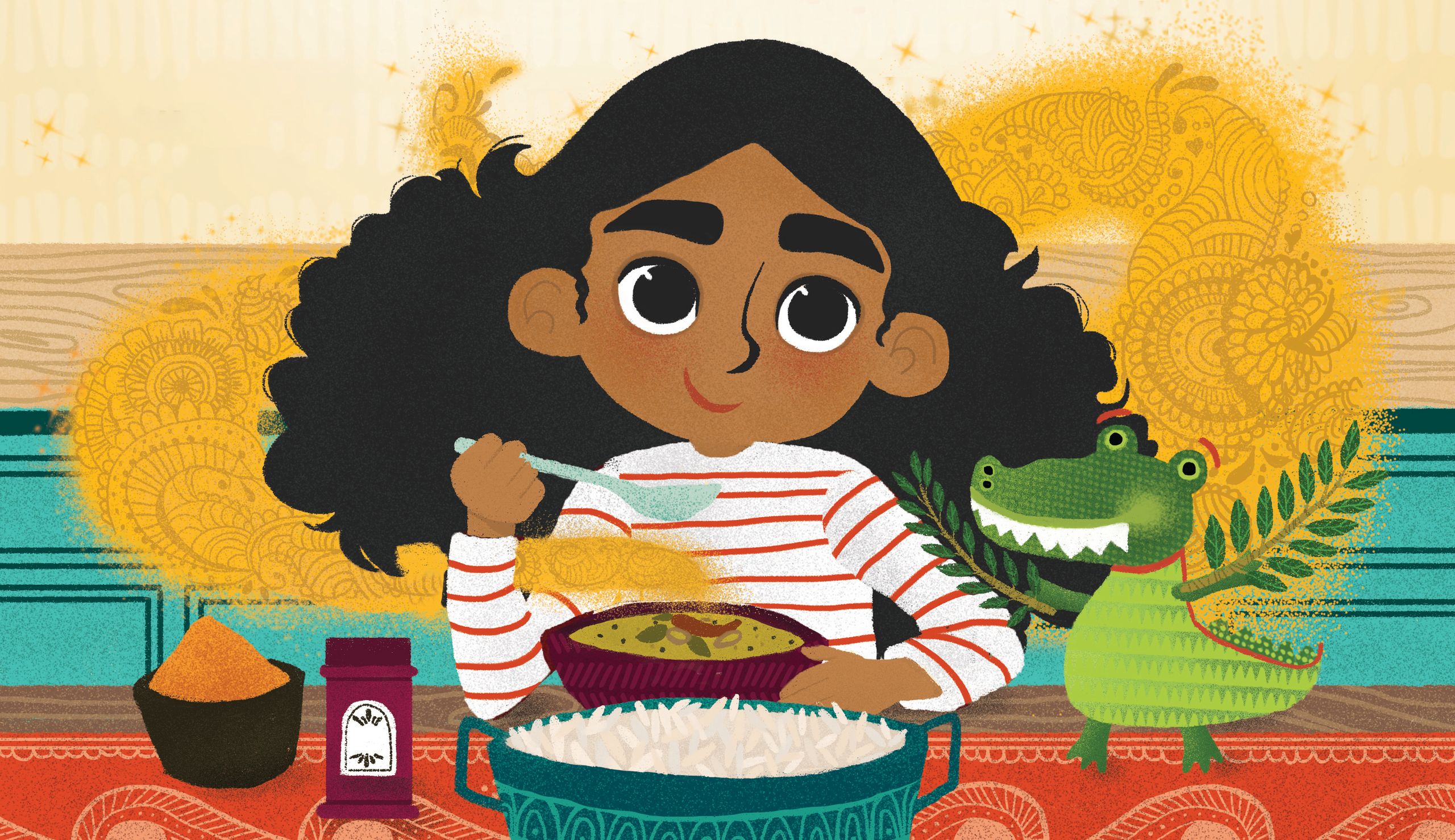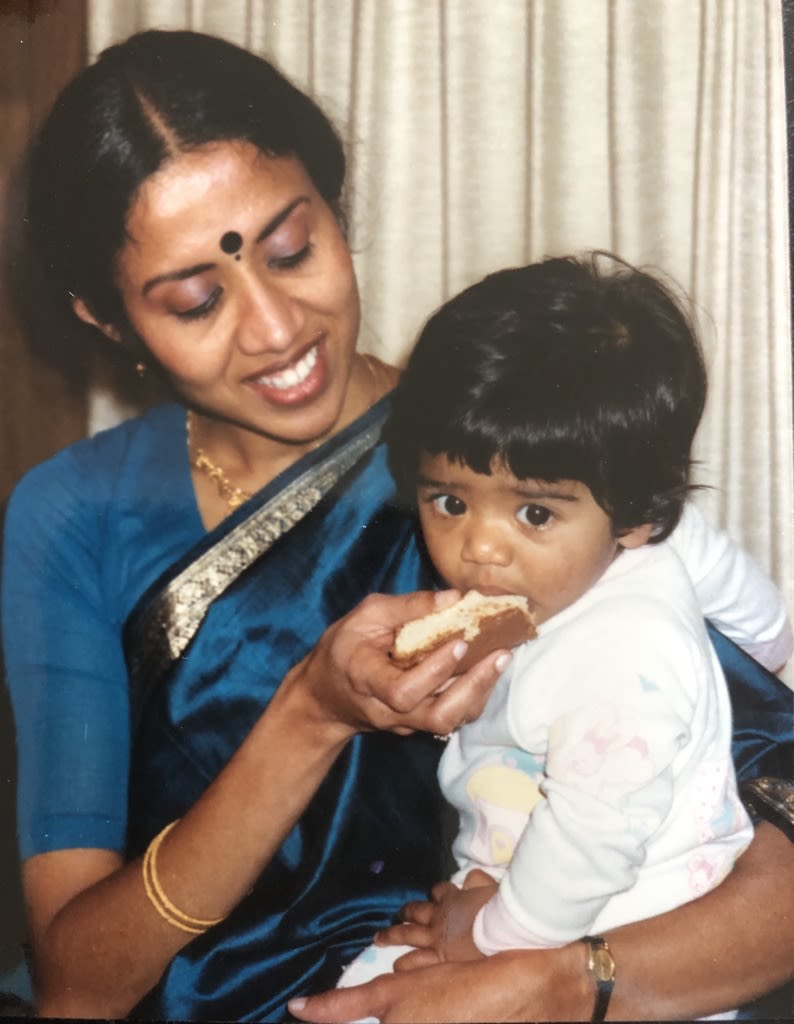Mind open,
fork ready
Kalamata's Kitchen | Sarah Thomas (2009)

Sarah Thomas, who completed an MPhil in English Literature at Clare in 2010, is now the co-founder and Chief Imaginator at Kalamata’s Kitchen, a children’s book series focused on teaching curiosity and compassion through food. We spoke to her about how her years of experience in hospitality helped to inspire Kalamata’s stories, and how she’s giving back at a time when the industry is really struggling.

Can you tell me about where your career has taken you since leaving Clare?
My undergraduate career actually started in Pre-Med, before I switched over to English for my MPhil at Clare. After that I moved back home. Because I’d been in academia for so long, I decided that I wanted to do some work on the side which was completely unrelated, so I fell into the restaurant industry and became first a bartender and then a sommelier. I studied for my advanced sommelier degree and worked for about four years as a wine professional in Pittsburgh. Then for six years, I was a sommelier at Le Bernardin, a Michelin three-star restaurant in New York City. I really enjoyed the rigours of studying wine – and there’s so much to study. But although I loved it, and loved service, I knew it wasn’t going to be the height of my career.
As I was looking to transition out of the restaurant industry, a friend, Derek Wallace, approached me with an idea to create a character that would encourage children to be open-minded with food. I always enjoyed working with children, and I was looking to get back into writing. I thought his idea was brilliant, and Derek is now my business partner and the co-founder of Kalamata’s Kitchen.

Sarah (centre), with her business partner, Derek Wallace, and illustrator, Jo Kosemides Edwards
Sarah (centre), with her business partner, Derek Wallace, and illustrator, Jo Kosemides Edwards
It was 2017 when we started in earnest with the company, and since then it has grown and grown. Our goal is to inspire children to learn about the world through adventures with food. From 2017 to early 2020, I was working both as a sommelier and for Kalamata’s Kitchen, but working normal hours plus restaurant hours don’t really mix! Right before the pandemic hit, I officially left Le Bernardin to focus full time on the business, and despite the world turning upside-down, I feel lucky to say that we are doing very well.
How did your experience at Le Bernardin come into play in the creation of Kalamata’s Kitchen?
As cheesy as it sounds, at Le Bernardin and in hospitality more generally, I enjoy creating experiences for people. As a sommelier, your job is to guide the guest to whatever their best experience is – some people know exactly what they want, some people prefer to be led – and I loved trying to read people to figure that out. The vocabulary that you use to create an experience for a grown-up, to convince them to try something new, is the same vocabulary and persuasion method that you could use for a child. What you’re really saying is, “This new thing will be fun for you if you try it – are you open-minded enough to try?” As adults, we engage and push back a bit with each other, but for children we often feel the need to force that ideology on them. At Kalamata’s Kitchen, we try to empower children to see the experience as an adventure, because adventures are fun, and to make it seem as if it is all their idea.
That’s where I see the connection with hospitality, because what we’re asking for is open-mindedness. I think the best way to summarise it is through what we call the ‘Taste Bud Pledge’. At Kalamata’s Kitchen we call all our friends who take the pledge ‘Taste Buds’, and the pledge goes like this:
“I promise to keep my mind open, my fork ready, to try each new food at least two times, and to share what’s on my plate when someone doesn’t have enough.”
In the hospitality industry, we recognise that food is nourishing and joyful, but it can also be a way to care for others.
Where did the inspiration for Kalamata come from? She is beautifully illustrated by Jo Edwards in your books. Was this the result of collaboration, or did you always have a strong picture in your head of how she might look?

It was interesting because I had so many of Kalamata’s stories in my head already, and had the idea of what the character could be, but I can’t draw to save my life, so I knew I had to find someone who could take my descriptions and bring them to life. I feel like she always looked this way in my mind but it’s hard to untangle the real genesis of it all because Jo is really the one who gave Kalamata her beautiful face.
We knew Jo was going to be the perfect partner right from the start. I spoke to her about the curiosity in Kalamata’s eyes and the extent to which she is mirrored in my own life and childhood, and when she showed us the first pictures we just thought “That’s it. She nailed it!”. She was the first artist we saw, and though we had submissions from other artists, her work was so perfect, and you could tell she really understood Kalamata’s spirit. Now every time I tell Jo what I think I want to see on the page, I can trust her to make it even more beautiful.
I grew up in rural Pennsylvania and my childhood at home was very happy, but in my wider surroundings and in my town, I felt like I didn’t fit in as well. I didn’t become outwardly proud of my identity and my culture until I was a lot older, largely because of some negative interactions with children at school – they would comment on how my house smelled and things like that because my mom cooked Indian food all the time. I think about how different my childhood would have been if there had been a character like Kalamata when I was growing up – not just for me to see myself represented, but for those other kids to see a child that didn’t look like them as a hero and a friend. And though Kalamata does look a lot like me as a kid, when people ask if I am Kalamata, I always say “No – Kalamata is the little girl I wish I had been.”
She completely owns her big hair, her big eyebrows, and she’s proud not only of her identity, but celebrates the identities of all her friends too. I think that’s the kind of kid we want all our kids to be.
In the wake of the pandemic, it seems that for you and the team ‘sharing what’s on your plate’ has taken on renewed meaning – could you tell me more about that?
We always planned on building philanthropy into our business model – our first three self-published books all had a charitable component to them. We want to have a business that we can be proud of. When the pandemic hit, there were so many families in need – and so many people in the restaurant industry in need – and we saw it as an opportunity to hold ourselves to that standard.
Back at the beginning of the pandemic, we were due to give a fifteen-minute speech at the South by Southwest festival on building a more compassionate world through food. When the festival was cancelled, we launched a campaign called #Give15 instead, where every day for fifteen days we found a way to give back to our restaurant community and the families that needed help. We tried not only to give as much as we could, but also to amplify the great work that others were doing in their communities. Sharing what’s on your plate isn’t just about donating money and resources, it’s about demonstrating compassionate behaviour. We made a series of free activity guides for our website, with a template for kids to, say, write a love letter to their favourite restaurant that had to close or contact an elderly relative and do what they could to make sure people didn’t feel lonely. We hope that if children cultivate a sense of empathy at a young age, they are much more likely when they get older to make decisions with their resources that benefit other human beings.
In the future, our goal is for our products to always have a ‘give back’ component. Almost everything we’ve produced so far has had a percentage of sales go to charity, either to one of our own choosing or that of our chef collaborators. They have a big influence on where we direct our donations. We’re also planning some really foundational campaigns around childhood food insecurity, which will be announced later this year.
Why do you think it’s so important for children to be adventurous with food?
To be adventurous is really to be open-minded, to be excited about the possibility of the unfamiliar. Adventure sounds fun, and that’s a great way to explain it to kids. Once you’ve crossed that threshold of overcoming what is unfamiliar to you, the world opens up in a whole new way. Food is the easiest handshake into another person’s life – it’s something that every human on the planet experiences. Even if someone looks and sounds different from you, you can still share a meal with them. We fundamentally believe that when children are taught to overcome the initial fear of trying something new through food, they’re learning that things aren’t as scary as they seem, and that’s something which can translate to pretty much every aspect of life. It’s really all about reminding kids that they can be curious enough to want to try something new, courageous enough to actually do it and compassionate enough to share that experience with another person.
What new food experiences have you discovered recently?
I consider myself a really adventurous eater. I have the unofficial moniker of the ‘try-things-twicer’. I will try anything, and then try it again! Throughout the pandemic, like everyone else I’ve been cooking a lot more from home. I just tried making a delicious lamb and groundnut stew by London-based chef Zoe Adjonyoh, from the awesome cookbook Zoe’s Ghana Kitchen. It had a chilli in it that I had never heard of before, so it was fun for me to try to hunt it down, especially while not being able to go to markets as usual.
Under usual circumstances, you can find anything in New York City, and ordinarily I would hear about a dish like this and then try to go out and find a really authentic Ghanaian restaurant and eat there, but now because I can’t do that I feel like I have to try and experience it from my own home. So my food adventures lately have been about trying to make myself a less terrible cook!
Who inspires you?
I have a lot of incredible women around me. First and foremost, my mom. So many of my childhood memories are of my mom’s kitchen; she was always cooking. I had such a strong sense of home when I was a child, because no matter what happened at school, my house always smelled comforting. I have such a deep sense of nostalgia and personhood from those memories. She was and is a great host and would feed people tirelessly. Even if you just stopped by to say ‘hi’, she would say, “Do you want tea? I don’t care – you’re having everything”, and start cooking! That sense of abundance, of making sure that your guests always have more than enough, still really resonates with me.

Sarah's mother feeding her as a child
Sarah's mother feeding her as a child
So many of the people I’ve worked with in the restaurant industry inspire me and have taught me so much about real life. My best friend and former chef in Pittsburgh, Jamilka Borges, is one of the hardest workers I’ve ever met. Her work ethic, vision and constant desire to give back to her community are endlessly inspiring to me.
My grandmother, who is sadly no longer with us, was just my favourite person. She had this intense love for reading and for getting completely lost in whatever she was doing. She got teased for it – I remember people saying how flighty she was – but who has that kind of focus anymore? Nobody! I always admired that, and her ability to be transported in her own mind. She was a physician, a mother to seven and oversaw an entire working farm, and yet she could give herself entirely to whatever she was reading at the time.
I believe that the lessons you can learn from chefs are much bigger than their recipes. One of the coolest parts of my job is that every day I get to interview inspiring people and share their lessons with families. If you scroll through the Kalamata’s Kitchen Mind Open, Fork Ready blog, you can see profiles of chefs, each of whom deeply inspire me.
What’s next for you and Kalamata?
There’s a lot in the works this year. Our first three independently published books are sold out and we have now signed a multi-book deal with Penguin Random House, the first of which will be coming out in July. It’s based on my own childhood. Kalamata is discovering what makes her special through her senses as her mother is making dal in her kitchen.
We’ll also be launching a few chef-driven and philanthropic initiatives to help us spread the message of the Taste Bud Pledge.
There’s an animated series in the works, too, which we have always seen as a great opportunity to get Kalamata into as many homes as possible. Animation is time-consuming though, so this won’t be out for a while – but we’re working on it!
In the meantime we have a great variety of free resources and digital activity guides for families who have been stuck at home due to the pandemic, to help them discover fun through food in their own kitchens.
Kalamata’s Kitchen, out July 2021, is available to pre-order now. www.kalamataskitchen.com

